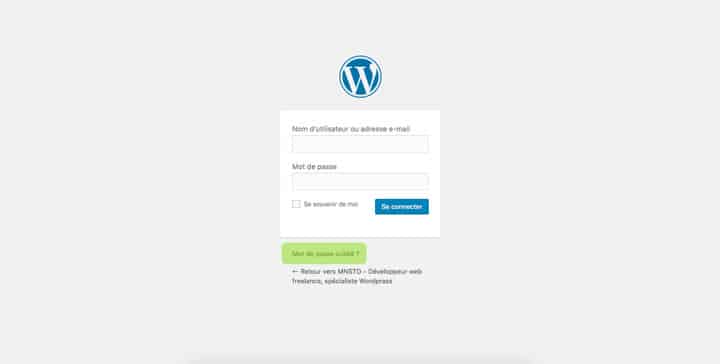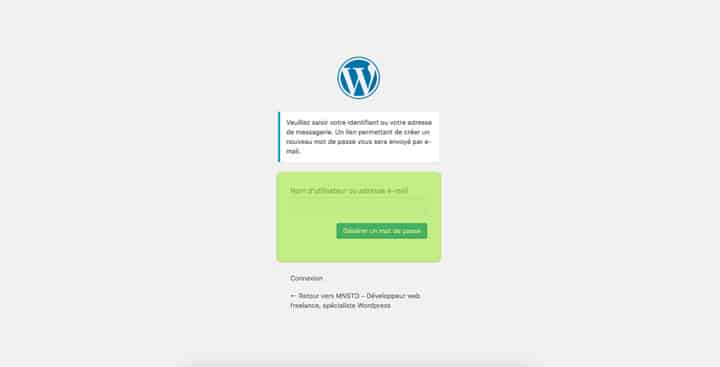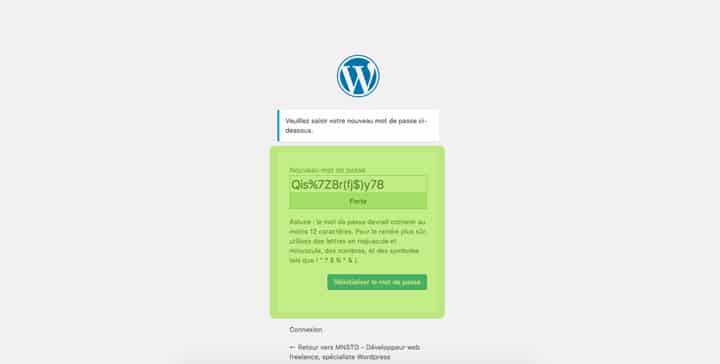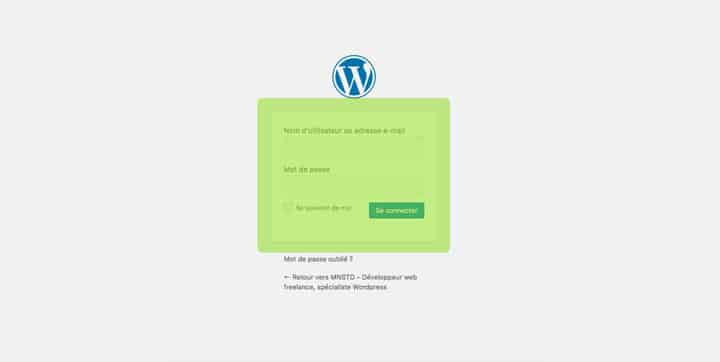“I can’t find my WordPress login page” are very common words for any WordPress freelance developer. Whether for a showcase website, an eCommerce website or a catalog website, it is true that the question “Where is my WordPress login page located?” is one of the most frequently asked questions. We will see here, whether you are a beginner or a confirmed user, how to find your Login page , Login to the WordPress dashboard, but also how to modify it and make it safer.
Why do you need the URL of the Connection page, WordPress Login?
The WordPress login page is the gateway to your back office , your dashboard also called Admin. It allows you to access the management of your website but especially of your Home page, to add media, to modify your design, to modify your Widgets, to write articles, pages, to manage your online store,…
It is therefore essential to know how it works and how to connect to it.
Where can I find my Connection page, WordPress Login? WP Login or WP Admin?
WordPress offers two dashboard entry doors, the WP Login and the WP Admin .
What is the interest, will you tell me? Well, WordPress distinguishes users in two general categories: editorials and technical .
Editorials group subscribers, authors, contributors by default, and techniques group publishers and administrators.
So which entry door for which profile?
What is the WP Login?
The WP Login allows all users of a WordPress website to easily connect to your dashboard. This is generally the classic url to which you will point your editorial and technical users and thus allow them to access their personal space .
What is WP Admin?
The WP Admin is the landing url of your Dashboard . When you are already connected, which is generally the case for so-called “technical” profiles, your WordPress Admin automatically appears from WP Admin. On the other hand, when you are not connected, which is the case for so-called “editorial” users, WordPress redirects you to the WP Login connection page.
How do I log into my dashboard?
When WordPress has been integrated correctly, all you have to do is add the terms / login or / admin after your main url:
- www.example.com/login
or
- www.example.com/admin
These two URLs will redirect you to the WordPress login page.
If for some reason this was not the case, please modify the /login or /admin by /wp-login , as follows:
- www.example.com/login
to replace with
- www.example.com/wp-login
If your WordPress website is installed on a subdomain , here is the procedure to follow:
- www.subdomain.example.fr/login
or
- www.subdomain.example.fr/wp-login
Once connected you will be redirected to your WordPress Dashboard which is located at /wp-admin.
You can then directly access your WordPress admin via the following URL:
- www.example.com/admin
or
- www.example.com/wp-admin
This Admin Login URL checks if you are logged into your WordPress or if your session is still in progress. If this is no longer the case, you will be redirected directly to your login page.
What should I do when I have lost my password, my WordPress login codes?
No panic, nothing is immutable! Whether you created your member area yourself or had it done for you, WordPress requires by defaults an username, email address, and password. The password can be generated automatically but we recommend that you define one yourself. It will be easier to find it later.
If you have lost your password but know your email or username, follow this tutorial:
- Go to the /login or wp-login page and click on the “Forgotten password” link present below the login form. You will be redirected to the screen /wp-login.php?action=lostpassword.
- Fill in your username or member email address and click on “Generate a password”. WordPress will then send you an email to your member email address containing a link to renew your password. Follow it.
- Then, you arrive on a page which suggests a new password. If you wish to keep it, note it well! If you’re afraid of not remembering it, customize it to your liking . We advise you to use numbers, letters, accented characters to make it as less simple as possible.
- Once done, click on “Reset password” and log in!
If you’ve lost your email and don’t know your username , the process is a little more complicated but not impossible. The simplest solution would be to recreate a member account, but you will no longer be able to access your previously stored data. Not very practical when you are the author or customer of a shop WooCommerce .
We therefore advise you to contact the website administrator . The admin of a WordPress website has access to all data. Please note, it does not have access to private data such as a password or bank details, but to text data such as your Last name, First name (if defined), email address, etc.
If you know the administrator of your website, send him your contact details, your usual emails, those that you usually use, so he can find you with a quick search.
If you don’t know it, which may be the case when you’re a client or an author, browse the website for a contact email. This is usually found on the Contact or Legal notices . Contact this email address and send him your usual contact details or emails.
An email will be sent to you to reset your password and you will be able to access your member area again.
How can I secure my WordPress login page?
Some people or malware may try to access your website’s dashboard while they are not invited to do so. Several techniques are possible to prevent any intrusion.
- Installation of a Google Captcha : Google offers a small plugin very easy to use which will allow you to install a Captcha or an “I am not a robot” box. It will limit the possibility for software to multiply connection attempts.
- Restrict the number of connection attempts : Via the plugin Login Lock Down , which records the IP and timestamp of connection attempts you will be able to recognize when you are attacked or not. By limiting the number of connection attempts you will limit the possibilities of third-party connection.
- Change the access URL to your login page : Malware knows the urls /wp-login and /wp-admin. They use it as entry points to attack websites, steal content, spam, etc. By modifying them, you will pass outside their radars and increase your security.
How can I change the url of my WordPress login page?
As seen above, changing the url of the WordPress login page helps protect against any malicious attack by a software or a bad person intended. But you may also need to change this URL for practical or marketing reasons.
Several techniques are then possible:
- Using a plugin (Method for beginners, or people who have no code knowledge): The ideal tool is WPS Hide Login . Simple and light, it allows you to quickly change the url of your login page to the one of your choice. It does not modify the WordPress core itself, but prevents access to the page /wp-login and /wp-admin. If, for a reason, you would no longer wish to use it, deactivate it the basic WordPress installation would be active again.
- The modification of the url by the .htaccess (Method requiring elementary notions of code): Ideal if you do not wish to install an other plugin, this technique will simply change the url to access the login page. To do so, follow the guide:
-
- Connect to your FTP via your favorite software
- Find the .htaccess file at the root of your /www. Be careful, it may be hidden or not created. Modify your FTP options if this is the case or create the file
- Open it in your code editor and find the line #BEGIN WordPress
- Above this, add the following line: RewriteRule ^ login $ http://NOM_DU_SITE.com/wp-login.php [NC, L]
- Then, modify the url of your site and the first term ^ login $ by the one of your choice:
example, if you use ^ connexion $ the connection page of my WordPress site will become http://www.example.fr/connexion - Finally Save your .htaccess file
Your new url is now active. Please note, this second technique is less secure. It’s just a simple redirect.
How can I change the appearance of my WordPress login page?
Because a personalized environment strengthens your image , you may need to change the appearance of your WordPress sign-in page. Unfortunately, WordPress does not offer by default the possibility of modifying this element simply from the dashboard. To do this, two solutions are possible, one per plugin, another directly in the code.
Modify your WordPress login page by using a plugin
Several plugins will allow you to change the web design of your Login page. We can recommend Custom Login , Customize WordPress Login Page or Custom Login Page Customizer . They are fairly well rated on the WordPress “store”, you will not take too many risks in use. Also quite simple to use, they will allow you to change your colors, your typographies, your background, to increase sizes, margins, paddings , … Ideal for novices!
Modify your WordPress login page by modifying the code
We will stop there for a longer time. You may have noticed that the Login part of WordPress is not part of your theme . If you modify the CSS elements of your Login page from your basic style.css sheet, the modifications will not be taken into account. But we can of course ignore it. To do this:
- Create a /login folder in your theme directory
- In this directory create a new file and call mnstd-login-style.css
- In your functions.php file , call this file so that it is taken into account by WordPress, using this small code:
function mnstd_custom_login () {
echo ”;
}
add_action (‘login_head’, ‘mnstd_custom_login’);
Your new stylesheet is active , you can now modify the design of your login page.
All the elements on this page are potentially modifiable, we will see here how to modify your background , add a new logo , change the default url of it and remove the “Forgotten password” and “Return to site” links .
Change the background of your login page
On your mnstd-login-style.css stylesheet, add the following lines:
body . login {
background-image: url (‘my-background-login.jpg’);
background-repeat: no-repeat;
background-attachment: fixed;
background-position: center;
}
Change the url of your background-image to the url of your choice. The background will be suitable for all screens . If you want to use a different background than that of your site, we advise you to add your .jpg file inside the /login folder that you have just created.
Change the logo of your login page and change the default url
On the connection page, WordPress offers by default its logo and a link to its site wordpress.org . The ideal would be to modify this to have our own logo and a link to your home page for example.
- On your mnstd-login-style.css stylesheet, add the following lines to modify the logo:
.login h1 a {
background-image: url (‘my-logo-login.png’);
}
Change the url of your background-image to the url of your choice. If you want to use a different logo from that of your site, we recommend that you add your .png file inside the /login folder that you have just created.
- On your functions.php file, add the following lines to modify the url:
function mnstd_login_logo_url () {
return get_bloginfo (‘url’);
}
add_filter (‘login_headerurl’, ‘mnstd_login_logo_url’);
function mnstd_login_logo_url_title () {
return ‘Your site name and description’;
}
add_filter (‘login_headertitle’, ‘mnstd_login_logo_url_title’);
Just remember to modify the line containing “Your site name and description” by your actual site name and its description. It’s just the alt=”” tag that will appear on your logo.
Remove the “forgotten password” and “return to the site” links
For aesthetic or technical reasons, you wish to remove these links from the login page. To do this, nothing more simple than a small “display: none; “
- For the link of Forgotten password :
p # nav {
display: none;
}
- For the link to Return to the site :
p # backtoblog {
display: none;
}
And now, with a minimum of customization, your login page is now your image! You are free to go further … A beautiful login page will encourage your visitors to connect and give a better image of your website. But don’t forget, this page should load quickly and be easy to use.
In summary:
- To connect: /wp-login
- To access your Dashboard directly: /wp-admin
- I lost my password, what should I do? : Click on “Forgot password” on the /wp-login page or request a new password from the site administrator
- To protect my login page: Google Captcha, Restrict the number of login attempts and Change the page url
- To modify my login page url: I use a plugin or I use the .htaccess.
- To change the appearance of my login page: I use a plugin or I add a style sheet to WordPress
As you can see, the WordPress login page is a major part of WordPress. Whether you are the administrator of your website, author or simple user, it will allow you to access your member area and modify the content to which you have access and are authorized. This is a gateway to the administration of your site. Well secured, it will protect you against attacks by people, malware, and hacking attempts. Finally, with a few lines of code, you can offer your visitors a personalized web design environment and thus improve your image.





